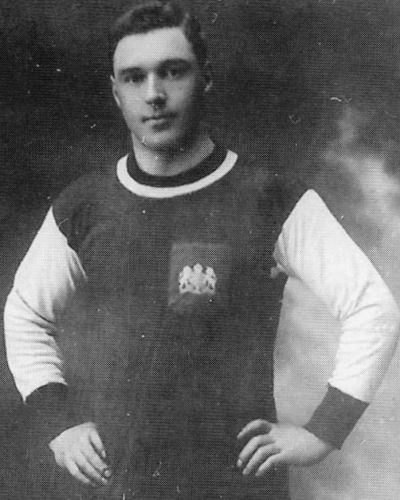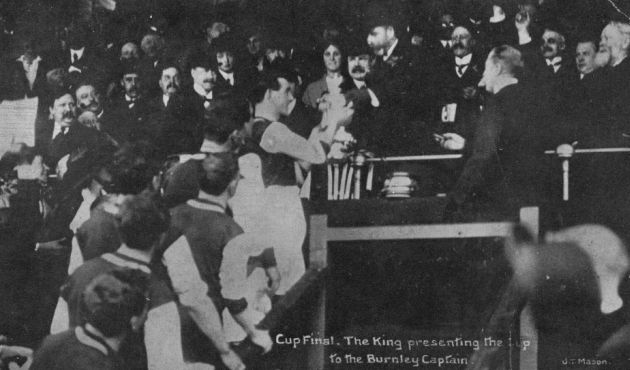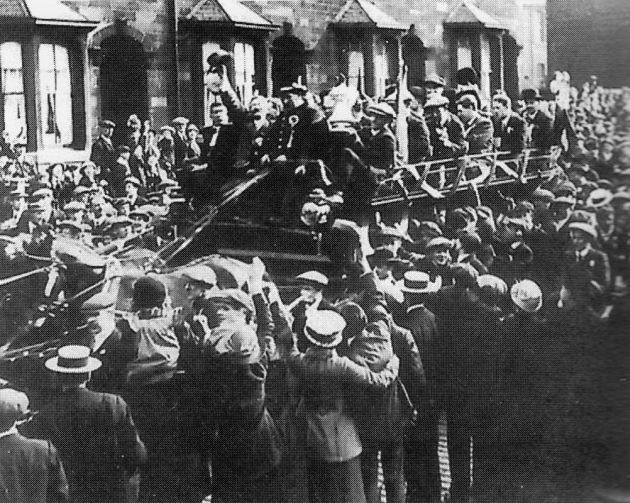The supporters of the time wanted to see changes. Director Mr R. H. Wadge had taken charge of the team in the absence of a manager but he'd returned to his directorial duties.
Whittaker had joined Burnley from Accrington and there was a clamour from the supporters for real change, for the club to push the boat out and bring in someone with vast experience.
They didn't get what they wanted. There was no change of policy and the club again turned to another Accringtonian whose only Football League experience had come as secretary of his local club. The new manager was John Haworth and it is fair to say, from the reaction, that it was not greeted with too much enthusiasm.
It was a bad summer for football with players threatening strike action but the season did finally get underway on time at the beginning of September and it was a new era for Burnley Football Club in more ways than one.
 |
| Bert Freeman was signed towards the end of the 1910/11 season |
This was now John Haworth’s Burnley, and he made an immediate change, one that remains with Burnley Football Club to this day. For the previous decade we'd played in green but Haworth wanted a change. Aston Villa had won the First Division of 1909/10. So it was their claret and blue colours that we adopted and when the 1910/11 season opened with a home game against Lincoln it was in the new claret and blue, Burnley Football Club had become 'The Clarets'.
The season did bring about an improvement in the league, but still nowhere near the promotion that was hoped for. We ended it in 8th place, six places higher than in the previous season but it was away from the league where the excitement came.
Wins against Exeter, Barnsley and Coventry in the FA Cup, and all without conceding a goal, took us to the fourth round. That's as far as it went. We lost 1-0 at Bradford City in that fourth round tie but the money made from the cup run enabled Haworth to strengthen his team with the most unlikely of signings.
With the season all but over, we brought Everton centre forward Bert Freeman to Turf Moor. Only two seasons earlier he'd been the First Division's leading goalscorer. He hadn't been playing as regularly for Everton but this was still considered a big signing for a Second Division club. It certainly provided a clear message from the club that the aim was to get back into the First Division.
Freeman played in two of the last three games of the 1910/11 season without scoring, but he got the 1911/12 season off to a good start. We won all of the first four games and he scored in all four of them.
He scored in the next two games too and goalscoring certainly wasn't the problem. It would be December before we failed to score in a game.
Defensively it might have been better and if the signing of Freeman was to ultimately be a significant one, then the next signing most definitely was.
Just before the end of September we made the whole football world sit up and take notice when we signed Barnsley centre half Tommy Boyle. Supporters struggled to take it in, such was the magnitude of this signing, but Burnley had pushed the boat out with a record fee believed to have been £1,150.
He made his debut against his old club Barnsley at Oakwell. We drew the game 1-1 as Freeman failed to score for the first time all season. Both were to feature very strongly for years to come at Turf Moor.
By the end of March we were five points clear at the top of the league with five games to play. Our two main rivals, Chelsea and Derby, had one and two games in hand respectively, but even so it would take a disaster to prevent us from winning promotion.
Sadly, that disaster happened. We won only one of the last five games and lost three of them. The season ended with us two points behind the pair with Derby winning the league on goal average.
The clash with Derby in March had brought over 30,000 to Turf Moor with supporters full of hope, but as the season ended they were left shattered with Burnley facing another season in the Second Division, and this despite Freeman scoring 32 goals in 33 league appearances.
Eddie Mosscrop, a Southport schoolteacher, was the big summer signing in 1912 and he began to share the outside right berth with Billy Nesbitt during the next season.
If things hadn't ended well for Burnley in 1911/12 season there wasn't much longer to wait as Haworth, in his third season in charge, returned the club to the top division as well as enjoying our best cup run yet.
There was no early change. A draw at Bury on the second Saturday in November left us in 8th place in the table and having played more games than all but one other team in the league.
Another 'average at best' season was being predicted but a 5-0 home win against Fulham on 16th November 1912 changed things dramatically. It started a run of ten consecutive wins that left us a point clear at the top of the table by mid-January.
In those ten games we scored an incredible 37 goals with Freeman getting 14 of them, and by that time we'd also beaten Leeds City in the 1st round of the FA Cup and he'd scored one of the goals in a 3-1 win.
Wins against Middlesbrough and Gainsborough won us a trip to Ewood Park for the quarter-final. Over 20,000 Burnley fans made the short journey over to see Boyle, now captain of the team, score the only goal to give us our first ever semi-final.
We were drawn against Sunderland and one week after the victory at Blackburn came news of another signing, that of Scotsman George Halley from Bradford Park Avenue.
He made his debut in a 3-1 home win against Bury on 15th March 1913. The half back line that day, for the first ever time, read: Halley, Boyle and Watson.
Unfortunately there was to be no cup final for Burnley. After a 0-0 semi-final draw at Bramall Lane we were beaten 3-2 by Sunderland in the replay at St. Andrew's.
 |
| Captain Tommy Boyle receives the FA Cup from King George V |
There was still work to be done as league action resumed. We were in second place, five points behind leaders Preston and just one point ahead of Birmingham who had a game in hand.
This time there was to be no slip up. We won four of the last six, picked up nine points out of twelve and were comfortably second at the end of the season. After thirteen years Burnley were once again a First Division club.
I'm sure most supporters would have been happy to finish 12th in 1913/14 having returned to the top flight. It was a season where were always comfortable with no threat of an immediate relegation.
An average season then in the league, but certainly not in the cup. South Shields, Derby and Bolton were all beaten before we exacted revenge on Sunderland in round four.
This time we faced Sheffield United in the semi-finals. Again we drew 0-0, this time at Old Trafford, but that's where the similarities ended. Boyle scored the only goal in the Goodison Park replay to take Burnley to a first ever final against Liverpool, also first time finalists.
On 25th April 1914 at Crystal Palace, Freeman scored the only goal of the game and Burnley Football Club had won its first major honour with captain Boyle receiving the cup from King George V, the first time the monarch had attended the cup final. Who cares who the league champions were that season; Burnley were FA Cup winners and returned home in triumph.
That was just the start. By mid-March of 1915 we were again just below half way in the table. Then came another inspired run as the season ended with seven wins and two draws in the last nine games.
That saw us earn a fourth place finish; the second best finish in the club's history to date. There was a strong belief that we could be strong challengers for the title in 1915/16 season.
 |
| The team returns home as cup winners |
There wasn't to be a 1915/16 season. By the time it was due to start we were at war. World War One began on 28th July 1914 and ended on 11th November 1918, the birthdate of an Oswaldtistle baby called George Bray who in time would go on and play a major role in the fortunes of Burnley Football Club for many years.
League football was suspended for four full seasons, finally returning on 30th August 1919. Burnley had lost players during the war and two, David Taylor and Teddy Hodgson, who had scored 19 times in our last pre-war season, were both very ill.
Taylor, thankfully, recovered to play again but Hodgson sadly passed away just under four weeks before the season started. He was aged just 33.
The only new signing made for the first team was right back Len Smelt and he went straight into the team as the season kicked off.
Supporters hoped that the promise and hope provided just before the war would not have been lost. It wasn't and we ended the decade in 2nd place although we were a massive eleven points behind champions West Brom.
It had been a decade that had surely exceeded all expectation. In six seasons of football we'd won promotion to the First Division, collected our first ever major honour and were officially the second best team in the country at the end ot the 1919/20 season.
John Haworth had been manager for ten years and the lack of excitement at his appointment was long gone – he and Burnley were on the verge of greatness.
